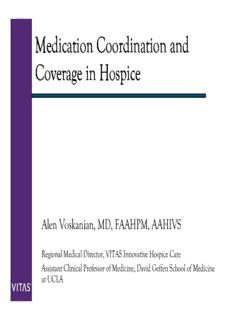
Medication Coordination and Coverage in Hospice PDF
Preview Medication Coordination and Coverage in Hospice
Medication Coordination and Coverage in Hospice Alen Voskanian, MD, FAAHPM, AAHIVS Regional Medical Director, VITAS Innovative Hospice Care Assistant Clinical Professor of Medicine, David Geffen School of Medicine at UCLA Objectives • Describe steps involved in medication coordination at the end of life •• DDiissccuussss tthhee rreevviisseedd MMeeddiiccaarree gguuiiddaannccee for medication coverage • Apply the regulation to three different clinical cases Goals of Medication Management • Best care for the patient – Drug-drug interactions –– AApppprroopprriiaattee mmeeddiiccaattiioonn aanndd mmeettaabboolliittee levels in a dying patient – Achieve therapeutic goals – Avoid side effects and adverse reactions • De-Prescribing • Improving the value Medication Coordination R.A.C 1. Medication Reconciliation 22.. MMeeddiiccaattiioonn AApppprroopprriiaatteenneessss 3. Medication Coverage R Medication econciliation R .A.C Obtain AND Verify a CCoommpplleettee AANNDD AAccccuurraattee list of Current Medications AND Match to Actual Prescribed Medication Medication Appropriateness A R. .C . Review all medications including over-the- counter drugs, vitamins and herbs. Then aasssseessss:: DD..EE..NN..II..MM..SS • Duplicates • Effectiveness • Necessity • Interactions • Monitoring requirement • Side effects Medication Coverage C R.A. • March: Medicare Part D plan sponsors will require prior authorization on all uunnrreellaatteedd mmeeddiiccaattiioonnss ffoorr hhoossppiiccee patients • July: Revised Guidance-Prior authorization ONLY required for 4 classes of drugs when the drug is NOT related to the terminal prognosis What are the 4 Classes? What are the 4 Classes? • Analgesics • Anti-emetics •• LLaaxxaattiivveess • Anti-anxiety COP 418.106 “Drugs and biologicals related to the palliation and management of the tteerrmmiinnaall iillllnneessss aanndd rreellaatteedd ccoonnddiittiioonnss,, aass identified in the hospice plan of care, must be provided by the hospice while the patient is under hospice care.”
Description: